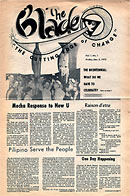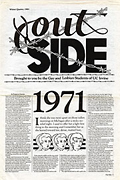During the 1970s, UCI's official news outlets paid little attention to issues concerning ethnic minority students. The need to have their issues and voices heard prompted these students to create their own news outlets.
Multicultural

The first alternative paper to hit UCI's news stands was The Blade, subtitled "The Cutting Edge for Change." It was founded to foster a "communicative link" among the "Third World" communities of the University. The objective of Black, Latino, and Asian students was "to fuse together into a single general minority students' voice the various factions that are currently protesting some particular aspect of this institution." Students from UCI's diverse student population expressed their voices via The Blade.
The Blade was funded by ASUCI and the newly created Cross Cultural Center (1974). "The Cross" was the first multicultural center on any of the campuses of the University of California. Originally planned as a monthly newspaper, internal and external problems limited The Blade to 13 issues in its 3 years of publication. Its first issue was published on December 5, 1975, and its last on December 6, 1978.
Photograph: The Blade (Irvine, CA), Vol. 1, No. 1, Dec. 1975. The Blade, The UC Irvine Libraries, Irvine, California, Accessed Oct. 18, 2017
African American

In September 1979, former staff members of The Blade decided to change the focus of the newspaper from Third World students to black students. The first issue with this new direction was printed in September 1979, and the volume numbering was restarted. The new version of The Blade was published until winter quarter 1989.
In fall 1990, Umoja news magazine began publication. Umoja's goal was to "address the current issues facing African Americans." Over time this quarterly publication has evolved into more of an artistic outlet.
Umoja (Irvine, CA), Winter 1990. Umoja, The UC Irvine Libraries, Irvine, California, Accessed Oct. 18, 2017
Photograph: Umoja (Irvine, CA), Vol.3, No. 1, Feb. 1991. Umoja, The UC Irvine Libraries, Irvine, California, Accessed Oct. 18, 2017
Latino

UCI's Latino community made its voice heard through the publication of La Voz Mestiza beginning in 1976. Articles were printed in both English and Spanish, a practice that would later lead to challenges from ASUCI administration concerning the publication of materials in languages other than English. La Voz Mestiza has been published continually since 1976, making it the second longest-running student newspaper at UCI.
La Voz Mestiza (Irvine, CA), May 1979. La Voz Mestiza, The UC Irvine Libraries, Irvine, California, Accessed Oct. 18, 2017
Photograph: La Voz Mestiza (Irvine, CA), Spring, 1987. La Voz Mestiza, The UC Irvine Libraries, Irvine, California, Accessed Oct. 18, 2017
Asian American and Pacific Islander American
Asian American and Pacific Islander American students produced their first newspaper during winter quarter 1983, East-West Ties, in conjunction with the Cross Cultural Center. Its goals were to improve communication among various Asian groups and the UCI community. This was achieved through articles, poetry, and stories in order to promote an "understanding and insight into" Asian heritage.
During winter 1991, East-West Ties changed titles and became Rice Paper. Continuing East-West's initiative to promote cultural understanding, Rice Paper's purpose was to also expand "what it means to be Asian." It was published until spring 1997.


Rice Paper (Irvine, CA), Vol.1, No. 1, 1991. Rice Paper, The UC Irvine Libraries, Irvine, California, Accessed Oct. 18, 2017
Photograph: Rice Paper (Irvine, CA), Vol.1, No. 2, 1991. Rice Paper, The UC Irvine Libraries, Irvine, California, Accessed Oct. 18, 2017
Lesbian/Gay/Bisexual/Transsexual (LGBT)

Out Side was the first student newspaper published by the lesbian and gay community at UCI as a forum to present lesbian/gay/bisexual/transsexual (LGBT) culture through "individual subjective thoughts, feelings, philosophies, and aesthetics." Out Side published from winter 1983 through spring 1985.
Debuting in 1986, The Phoenix proposed to serve the LGBT community by presenting "material with a gay and lesbian perspective." In fall 1991 The Phoenix became The Triangle Times, a title which the editor felt better represented the LGBT community. The Triangle Times continued publication until 1993.
It would be four years before another LGBT student newspaper was again published. In spring 1997 students created InQueery, which continued until 2005.
The Phoenix (Irvine, CA), Winter Quarter, 1991. The Phoenix, The UC Irvine Libraries, Irvine, California, Accessed Oct. 18, 2017
The Triangle Times (Irvine, CA), Vol.17, The Triangle Times, The UC Irvine Libraries, Irvine, California, Accessed Oct. 18, 2017
Photograph: Out Side (Irvine, CA), Vol.1, No. 1, Winter Quarter, 1983. Out Side, The UC Irvine Libraries, Irvine, California, Accessed Oct. 18, 2017
Muslim American

Alkalima, UCI's first news publication focusing on Muslim students' issues, has been published since 1997. Alkalima translates as "the word." Its goal is to provide a Muslim perspective on issues such as spirituality, student politics, and social questions, serving as a link between UCI's Muslim and non-Muslim communities.
Alkalima (Irvine, CA), 1997. Alkalima, The UC Irvine Libraries, Irvine, California, Accessed Oct. 18, 2017
Photograph: Alkalima (Irvine, CA), Vol.2, No. 3, Sept./Oct., 1993. Alkalima, The UC Irvine Libraries, Irvine, California, Accessed Oct. 18, 2017
Political

Politically conservative newspapers can be traced to the ephemeral newspaper DEPTH, which published two issues in spring 2001 and winter 2002. The Irvine Review first appeared in October 2002 and was established to provide "a conservative voice at UCI." It was initially funded by ASUCI, but soon after, the non-profit Irvine Review Foundation was created to raise funds for the publication. It continued until 2007.

The Irvine Progressive debuted in spring 2003 in both paper and digital formats. The publication is the creation of the Young Democrats of UCI, whose aim is to provide for the UCI community a "non-partisan publication dedicated to fostering political awareness and intelligent discussion." Although not affiliated with any political party, The Irvine Progressive represents the "liberal" side of the political scale.
DEPTH (Irvine, CA), Vol. 1, No. 1. May 14, 2001. DEPTH, The UC Irvine Libraries, Irvine, California, Accessed Oct. 20, 2017
Photograph: The Irvine Review (Irvine, CA), Vol. 3, No. 1. October, 2004. The Irvine Review, The UC Irvine Libraries, Irvine, California, Accessed Oct. 20, 2017
Photograph: The Irvine Progressive (Irvine, CA), Vol. 1, No. 2. May, 2003. The Irvine Progressive, The UC Irvine Libraries, Irvine, California, Accessed Oct. 20, 2017
Women

In 1984, Tapestry, the first student newspaper to focus on the issues concerning woman at UCI, was first published. Tapestry's origins can be traced to Her-Vine, a monthly newsletter first issued in 1977. Her-Vine's purpose was "to establish a communications network for the women of UCI." This was achieved through articles and the reporting of events pertaining to women. Her-Vine ran for seven years and ceased publication in spring 1984. Tapestry debuted in the fall of 1984 and ran until 1986. The goals of Tapestry remained akin to that of its predecessor.
Photograph: Tapestry (Irvine, CA), Vol. 5, No. 3, Spring, 1986. Tapestry, The UC Irvine Libraries, Irvine, California, Accessed Oct. 18, 2017

